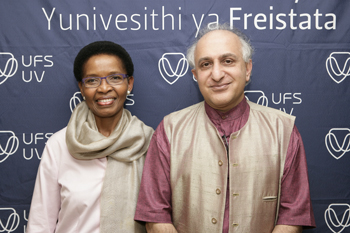Mellon Foundation awards R10 million research grant to Trauma, Forgiveness and Reconciliation Studies

Prof Pumla Gobodo-Madikizela, Senior Research Professor in Trauma, Forgiveness and Reconciliation Studies, and Dr Saleem Badat, Programme Director at the Mellon Foundation.
Photo: Johan Roux |
Through her profound insight, vast experience, and unfaltering belief in humanity, Prof Pumla Gobodo-Madikizela, has secured a R10 million grant from one of the world’s most prestigious foundations funding human sciences research.
“This is one of the biggest grants that the Andrew W. Mellon Foundation has awarded to a university”, said Dr Saleem Badat, Program Director: International Higher Education and Strategic Projects at the Mellon Foundation. Prof Badat attended the press event that took place on 16 February 2015 on our Bloemfontein Campus.
UFS Trauma, Forgiveness, and Reconciliation Studies, spearheaded by Prof Gobodo-Madikizela, will manage the research project.
Prof Jonathan Jansen, Vice-Chancellor and Rector of the UFS, expressed great excitement “about this particular grant and the subject on which it focuses is so incredibly timely and germane to our own situation.”
Trauma, Memory and Representations of the Past: Transforming Scholarship in the Humanities and Arts
This new-found partnership between the Mellon Foundation and the UFS will enable a five-year research programme. The focus area of this initiative will be ‘Trauma, Memory and Representations of the Past: Transforming Scholarship in the Humanities and Arts’.
The research will pivot specifically around the question of how trauma is transmitted from one generation to the next. “South Africa lends itself to these questions,” Prof Gobodo-Madikizela said, “because we are now dealing with a generation of young people who were born after the traumas of the past.” These past experiences, though, are “passed on to the younger generation and become their own stories and narratives as if they themselves experienced the traumas directly.”
“This is an investment in how we can in fact create a different kind of community,” Prof Jansen said, “in which we eventually recognise each other – not by the accident of our skin, but by that elusive sense of a common humanity.”
Arts and theatre
Other aspects critical to this study are the inclusion of the arts and theatre. Many people have great difficulty in expressing their experiences of trauma in the spoken word. The arts and theatre provide an ideal platform to engage the public and stimulate conversation. As an example of the power these platforms possess, Prof Gobodo-Madikizela highlighted the success of the Johannes Stegmann Art Gallery – situated on the Bloemfontein Campus and curated by Angela de Jesus – in engaging the public in very productive ways.
Participants
Some of the artists, directors and scholars who will join in this project include:
• Lara Foot-Newton, Director/Playwright
• Sue Williamson, Activist Artist
• Angela de Jesus, Visual Artist/Curator
• Dr Buhle Zuma, Social Psychology Research
• Dr Shose Khessi, Social Psychology Research
• Prof Tamara Shefer, Women’s and Gender Studies
• Prof Kopano Ratele, Gender/Men and Masculinities
• Prof Jan Coetzee, Sociology of Developing Societies
• Prof Helene Strauss, Literary and Cultural Studies
New intellectual frontiers
“There is an aspiration in this proposal,” Dr Saleem Badat said. “We were born through this pain of colonialism and apartheid; we even went through the TRC. Our scholars in this country, our universities, should be at the forefront of this research. This is not research we can leave to the institutions in the north.”
Prof Gobodo-Madikizela agreed. “The overarching theme of this work is new knowledge production, focusing on the experiences in South Africa as experiences that can teach us something new.”
This will serve not only South Africa, but can also establish support for, and inform, countries facing similar dilemmas. In fact, “any part of the world in which genocide and murder and racism remains as legacies from the past,” Dr Badat said.